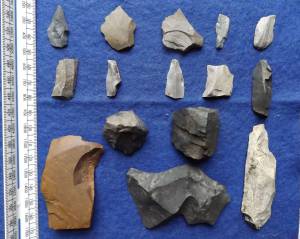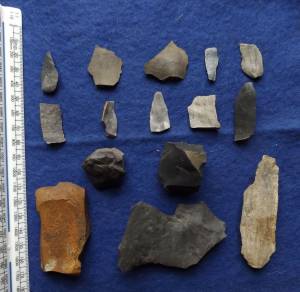|
| *****SWAAG_ID***** | 854 |
| Date Entered | 15/03/2015 |
| Updated on | 02/04/2015 |
| Recorded by | Tim Laurie |
| Category | Lithic Find / Scatter |
| Record Type | Archaeology |
| SWAAG Site Name | |
| Site Type | |
| Site Name | |
| Site Description | |
| Site Access | Public Access Land |
| Record Date | 05/03/2015 |
| Location | Carperby Moor |
| Civil Parish | Carperby Cum Thoresby |
| Brit. National Grid | Hidden |
| Altitude | 400m to 450m |
| Geology | The Main Limestone. |
| Record Name | Late-glacial lithic finds from Carperby Moor |
| Record Description | This record is a general introduction to the various finds of flint and chert artefacts from different locations on Carperby Moor which provide rare open-air evidence for an earliest human presence on the eastern Pennine Fringe. The evidence for the earliest human presence in Northern Britain has been recognised and radio-carbon dated from excavated cave deposits and from finds dredged up from the North Sea in the form of characteristic lithic finds and humanly modified and worked animal antler and bone. Open-air lithic finds from the fringe of the area briefly habitable during the 'relatively temperate Allerod oscillation' and short interglacial interlude named after the contemporary steppe-tundra vegetation as the 'Younger Dryas', are very uncommon in Britain. However, occupation sites of the earliest post-glacial hunters who followed herds of reindeer on their annual migration routes have long been recognised from Denmark, from North Germany, Poland and from the Baltic States.(Reference: Grahame Clark, 1975. The Earliest Post Glacial Settlement Of Scandinavia. Cambridge U.P.) A few lithic finds which are characteristic of these early reindeer hunter groups have been recognised from Carperby Moor, from locations centred at Thackthwaite Beck Springs and from other vantage sites which overlook small 'tarns, now infilled by peat. These few characteristic early lithic finds provide evidence for a rather brief and intermittent presence of Reindeer Hunters on the limestone uplands of the NE Pennine Fringe,which some 12,000- 10,000years ago were: 'a range of hills on the western edge of a vast European plain that, before rising sea levels flooded the lower ground to form the North Sea, stretched from the Pennines to the Urals' Reference Jacobi, R.M. 1978. 'Northern England in the Eighth millennium B.C: an essay,, in P.A.Mellars(ed.), The Earliest Postglacial Settlement of Northern Europe',295-332.
A few artefacts from Carperby Moor selected as being characteristic of the Ahrensbergian and Lyngby-Bromme, Northern European reindeer hunter culture dated to the period 12,000-10,000BC will be discussed here. These finds may be considered as, together with further recent finds from a small but increasing number of locations elsewhere in Northern England and from Western Scotland, forming the earliest evidence of post-glacial human activity in Northern Britain.
|
| Dimensions | See illustrations |
| Geographical area | |
| Species | |
| Scientific Name | |
| Common / Notable Species | |
| Tree and / or Stem Girth | |
| Tree: Position / Form / Status | |
| Tree Site ID | 0 |
| Associated Site SWAAG ID | 0 |
| Additional Notes | Note on the location of early prehistoric occupation sites:
The preferred locations for the occupation sites of Early Prehistoric Hunter groups are centred at the most constant springs, eg close to Thackthwite Beck Spring, or at vantage points on rising ground above open water, ie close to pools of open water or 'tarns' which today are moorland depressions infilled with peat.
The lithic evidence can be categorised as conforming to the known range of artefact forms which are understood to be diagnostic of the Late Upper Palaeolithic (LUP) 'Ahrensbergian' nomadic reindeer hunter cultures whose range extended from the Baltic and Northern Germany across the North Sea, then dry land, to Britain. The collection of artefacts from The Nab NNE of Thackthwaite Beck Springs, shown here on image nos 4,5 and 6 which are to be seen in the Wensleydale Museum Collection, detailed by Laurie (2003), Fig. 60, reproduced here as Image No 6, include a complete tanged point,No 1, the tip of a similar robust non-microlithic point, No 2, points on carefully made blades,for example No 12, good burins and heavy scrapers. The subsequent collections from Carperby Moor, shown as photo Image Nos 7-16, do share the general characteristics of the technology of this culture, but cannot be considered as diagnostic since these lithic forms are also present within the Mesolithic.
The type artefacts of the Ahrensbergian Culture include small, but non-microlithic tanged points which retain the bulb of percussion, and tanged points on carefully purpose struck pointed flakes which require no retouch except to form a basal shoulder or to 'thin' the bulb of percussion to facilitate hafting to the arrow shaft. Several examples of these shouldered flakes,from an occupation site overlooks an infilled glacial lake, which, being suitably light and strong, formed effective arrow armatures are shown on the illustrations below. These small simply struck flake points represent the invention and earliest use of the Bow and Arrow. (Reference: Grahame Clark, 1975. The Earliest Post Glacial Settlement Of Scandinavia. Cambridge U.P.) |
| Image 1 ID | 6153 Click image to enlarge |
| Image 1 Description | Thackthwaite Beck Cave (collapsed)and spring. This constant spring formed the focus of early post glacial hunter period and later prehistoric settlement at a vantage point which overlooks Upper Wenslydale. |  |
| Image 2 ID | 6139 Click image to enlarge |
| Image 2 Description | Early post glacial and Mesolithic hunter period occupation sites were located on rising ground overlooked small 'tarns' areas of open water now infilled with peat. |  |
| Image 3 ID | 6140 Click image to enlarge |
| Image 3 Description | The same infilled tarn seen from below. |  |
| Image 4 ID | 6135 Click image to enlarge |
| Image 4 Description | Finds of Late Glacial character collected during the last century from Carperby Moor, See Laurie 2003,Figure 60. |  |
| Image 5 ID | 6136 Click image to enlarge |
| Image 5 Description | Backed flint blade point with semblance of a tang of Late Glacial character. Laurie 2003,Figure 60, No 1 |  |
| Image 6 ID | 6137 Click image to enlarge |
| Image 6 Description | Finds of Late Glacial character collected from two locations NNE of Thackthwaite Beck Springs Carperby Moor, during the last century , Laurie 2003 Figure 60. |  |
| Image 7 ID | 6141 Click image to enlarge |
| Image 7 Description | Recent Finds from Carperby Moor. |  |
| Image 8 ID | 6142 Click image to enlarge |
| Image 8 Description | Recent Finds from Carperby Moor. Obverse view |  |
| Image 9 ID | 6154 Click image to enlarge |
| Image 9 Description | Selected recent finds from this site. Top: Small tanged point on carefully struck pointed flake, black chert.
Left centre: Small tanged burin, flint. Right centre: Tanged chert bladelet with retained bulb of percussion.
Lower centre: Two small robust points or burins on small chert flakes, one with bulb thinned for hafting by removal of a small flake.
|  |
| Image 10 ID | 6156 Click image to enlarge |
| Image 10 Description | The same, obverse view. |  |
| Image 11 ID | 6143 |
| Image 11 Description | Recent finds from an occupation site overlooking the 'Tarn' shown above. |  |
| Image 12 ID | 6149 |
| Image 12 Description | Recent finds from an occupation site overlooking the 'Tarn' shown above. |  |
| Image 13 ID | 6150 |
| Image 13 Description | Recent finds from an occupation site overlooking the 'Tarn' shown above. |  |
| Image 14 ID | 6144 |
| Image 14 Description | Detail. Chert blade. |  |
| Image 15 ID | 6145 |
| Image 15 Description | The same, obverse view. |  |
| Image 16 ID | 6146 |
| Image 16 Description | Blade segment. |  |
| Image 18 ID | 6134 |
| Image 18 Description | Stone circle above Thackthwaite Beck Springs, Embanked circle on Oxclose, after Raistrick 19**, and stray finds of Later prehistoric character from Carperby Moor. Laurie 2003, Figure 73. |  |
| Image 19 ID | 6148 |
| Image 19 Description | Carperby Moor, Location of Prehistoric Sites. Laurie, 2003 Figure 71. |  |

















